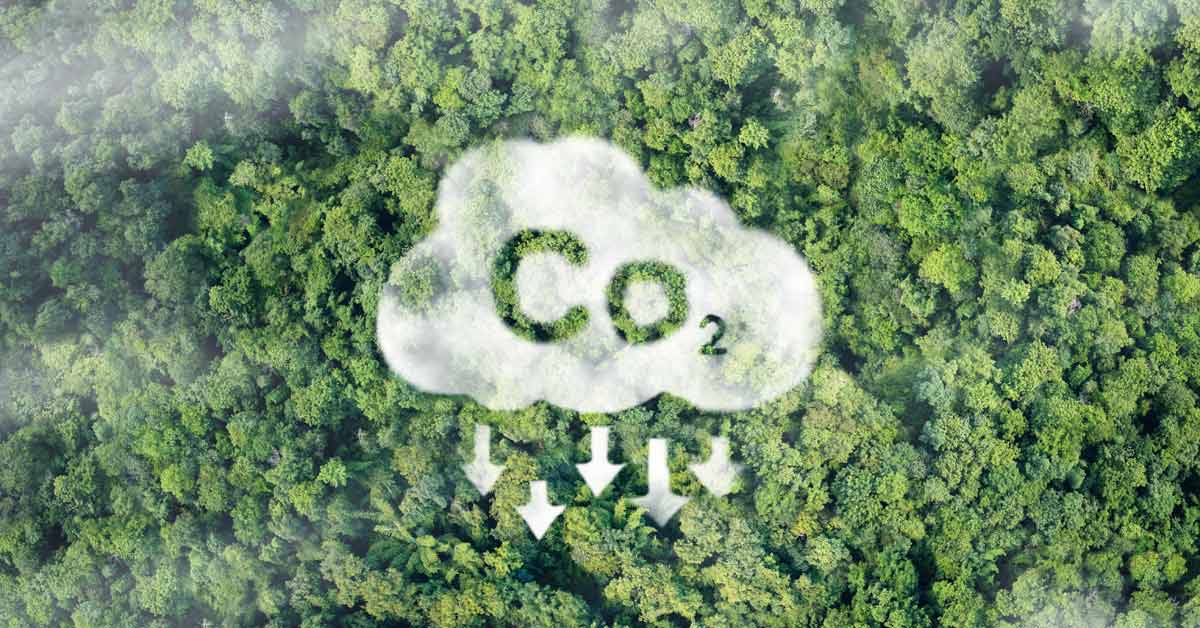4 min read
What are the 5 Types of Carbon Stores in Forests?
 Harvey Greer
:
Sep 21, 2023 12:00:00 AM
Harvey Greer
:
Sep 21, 2023 12:00:00 AM

A long-held assumption surrounding forests is that they serve as somewhat straightforward carbon sinks. Trees absorb carbon, and that carbon remains in the trees during their lifespans.
While this is definitely true, there is far more to carbon storage than a tree’s lifespan. Carbon stores will sit within woody biomass long after a tree dies or its branches or bark falls to the forest floor.
According to the US Forest Service, carbon is stored in 5 particular ecosystems relative to trees and forests:
1. Dead Wood
Any dead trees both standing and lying on the ground provide another important carbon store in the forest. Dead wood can continue to store carbon for several years. As it decays, the carbon typically will move into soil. It can potentially be absorbed by other plants as they utilize the dead wood to provide them with nutrients.
2. Biomass Above and Below Ground
A major contributor to total overall carbon storage, above and below ground biomass include the plants and roots in the underbrush of a forest.
Above ground, this means living plants such as shrubs, grass, sedge and the trees themselves. Below ground, root systems and their vegetation are classified this way. In-ground fruiting matter like stolons and rhizomes also count. Carbon is present and stored in all areas of a plant like the leaves, limbs, fruits and branches.
3. Tree Litter
Components of trees like leaves, twigs and needles are considered tree litter. These are distinct from the trees or dead wood due to the rapid nature of their carbon cycle. These elements continually fall and quickly decompose. Their stored carbon is then cycled into the soil.
4. Soil
Organic processes from decaying plant matter also provide a space to store carbon in the soil. In fact, soil serves as the largest carbon store within the forest ecosystem.
The decomposition process can store massive amounts of carbon in the soil. Nutrients through the natural lifecycle of the forest feed back into regrowing trees and vegetation.
5. Harvested Wood
Finally, harvested wood products can offer long-term carbon storage potential. Items like wood flooring or furniture could remain in use for decades. In many cases, their carbon storage outlasts trees and other stores in natural forests.
As sustainable initiatives move toward renewable resources, we’ll see a further push in wood products innovation. That will likely mean even more potential for long-term carbon storage throughout the forest products value chain.
Carbon Storage: Going Beyond the Forest
What can the breakdown of forest products and biomaterials tell us about how to approach carbon storage in forests?
As we discussed at the start of this post, the general assumption in forestry is that older trees mean more (and better) carbon storage. But this is not the complete story.
Older trees certainly function as effective carbon stores. However, they have a top limit where their CO2 storage potential declines.
Younger trees are actually more efficient at absorbing and using atmospheric carbon than older ones. Following this reasoning, it seems evident that we ought to encourage the growth of younger trees to increase carbon storage potential.
Does this mean that we can justify harvesting old-growth, untouched forests? Should we cut down the older trees that have reached their carbon storage capacity in favor of more efficient trees?
The answer to these questions, perhaps unsurprisingly, is “not quite.”
Again, we need to understand these findings in the overall context of forests, their wood, and all the various products they create. Carbon storage efficiency in younger trees does not mean that the forestry industry should continue cutting into untouched forests. In fact, in most cases the opposite is actually true.
What Carbon Storage in the Forest Really Looks Like
To clarify the issue, a glimpse into what’s going on within major forestry initiatives will help. Recently, a group of several global forestry companies announced the founding of the International Sustainable Forestry Coalition (ISFC). The ISFC aims to develop and follow sustainable forestry practices with a future-facing perspective.
As forest products and woody biomaterials increase in current and emerging uses (like biofuel), sustainable practices are imperative. The ISFC aims to help guide this process now and into the full transition of a circular bioeconomy.
From the perspective of the ISFC, the driving force to meet increased forest products demand comes through improving current practices. This means more efficient growing and harvesting of current plantations and stands without driving into old-growth or untouched forests.
According to the ISFC’s position paper on the issue:
“The nature of the forestry sector is evolving, and it is widely recognised that if we want a transition to a circular bioeconomy, we will need more forestry feedstock to be produced. We will need to accomplish this primarily by carefully intensifying plantations and semi-natural forests, not by extending the amount of timber harvested from virgin forests.” —ISFC Position Paper, Sept. 2023 (p.7)
Efficiency in growth and harvesting processes alongside a reduction in wood waste will directly contribute to the goals set out by the ISFC. These must work hand-in-hand with managed forest practices such as forest thinning, fuel reduction and prescribed burns. Following these guidelines will ensure a healthy forestry industry without the need to further cut untouched forestlands.
The Bigger Picture in Wood Products and Carbon
The fifth carbon storage area discussed above, harvested wood, brings up some additional considerations relative to long-term carbon storage. As we learn and understand more efficient ways to harvest wood products, we can also see further methods to improve carbon storage potential.
According to the Food and Agriculture Organization of the United Nations, harvested wood helps climate goals in two ways. First, it perpetuates the carbon storage within harvested wood potentially further than even natural processes. Second, it provides an alternative building material to replace higher carbon options such as plastics, composite, or even concrete.
Technology and circumstance are positioning wood products as one of the most important resources in a post-sustainability world. Understanding this growing need can also inform long-held assumptions about carbon storage in the trees and the products derived from them.
This concept opens itself up for all types of wood carbon stores. Only looking at carbon storage in the form of trees limits the scope of the problem. The limitation can also be used to justify potentially damaging effects such as continued deforestation. That reasoning could inevitably worsen the total effects of carbon input and output.
Instead, carbon storage within wood products should be assessed holistically. Demand will inevitably increase for wood products as the world moves toward sustainable energy. Technology will also likely bring new and exciting ways to utilize wood products for solutions to insulation, building materials, and more.
Recognizing the value of carbon stores across the forest products value chain can reshape how we approach their adoption and use. As the ISFC affirms, we can achieve our decarbonization goals with our current plantations and semi-natural forests. This will come through a collaborative effort in forestry companies, harvesters, scientists and policymakers alike.
The building blocks for the path to carbon zero are already in place. Now it’s time to get moving.
Subscribe to the ResourceWise Sustainability Blog for news, insights, and expert commentary on all the major issues within biofuels and renewables.





